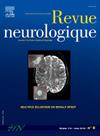重症肌无力的新治疗策略。
IF 2.8
4区 医学
Q2 CLINICAL NEUROLOGY
引用次数: 0
摘要
重症肌无力(MG)是一种以肌肉无力和疲劳为特征的慢性自身免疫性神经肌肉疾病。该病主要由针对神经肌肉接头处乙酰胆碱受体(AChR)和肌肉特异性激酶(MuSK)蛋白的抗体引起。传统的 MG 治疗方法,如乙酰胆碱酯酶抑制剂、皮质类固醇和免疫抑制剂,具有一定的疗效,但往往具有明显的长期副作用,而且患者的反应率也不尽相同。值得注意的是,约有 15% 的患者对这些标准疗法的反应不充分。分子疗法的最新进展,包括单克隆抗体、B 细胞清除剂、补体抑制剂、Fc 受体拮抗剂和基于嵌合抗原受体(CAR)T 细胞的疗法,为 MG 的治疗提供了前景广阔的替代疗法。这些新型治疗方法为靶向参与 MG 发病机制的特定免疫通路提供了潜在的改善途径。本综述重点介绍了开发和实施这些分子疗法所取得的进展和面临的挑战。它讨论了这些疗法的机制、疗效以及个性化医学在治疗 MG 方面的潜力。将新的分子疗法融入临床实践将极大地改变 MG 的治疗格局,为那些对传统疗法反应不佳的患者提供更有效、更有针对性的治疗方案。这些创新强调了持续研究和临床试验对优化治疗策略和提高 MG 患者生活质量的重要性。本文章由计算机程序翻译,如有差异,请以英文原文为准。
New treatment strategies in Myasthenia gravis
Myasthenia gravis (MG) is a chronic autoimmune neuromuscular disorder characterized by muscle weakness and fatigue. The disease is primarily caused by antibodies targeting acetylcholine receptors (AChR) and muscle-specific kinase (MuSK) proteins at the neuromuscular junction. Traditional treatments for MG, such as acetylcholinesterase inhibitors, corticosteroids, and immunosuppressants, have shown efficacy but are often associated with significant long-term side effects and variable patient response rates. Notably, approximately 15% of patients exhibit inadequate responses to these standard therapies. Recent advancements in molecular therapies, including monoclonal antibodies, B cell-depleting agents, complement inhibitors, Fc receptor antagonists, and chimeric antigen receptor (CAR) T cell-based therapies, have introduced promising alternatives for MG treatment. These novel therapeutic approaches offer potential improvements in targeting specific immune pathways involved in MG pathogenesis. This review highlights the progress and challenges in developing and implementing these molecular therapies. It discusses their mechanisms, efficacy, and the potential for personalized medicine in managing MG. The integration of new molecular therapies into clinical practice could significantly transform the treatment landscape of MG, offering more effective and tailored therapeutic options for patients who do not respond adequately to traditional treatments. These innovations underscore the importance of ongoing research and clinical trials to optimize therapeutic strategies and improve the quality of life for individuals with MG.
求助全文
通过发布文献求助,成功后即可免费获取论文全文。
去求助
来源期刊

Revue neurologique
医学-临床神经学
CiteScore
4.80
自引率
0.00%
发文量
598
审稿时长
55 days
期刊介绍:
The first issue of the Revue Neurologique, featuring an original article by Jean-Martin Charcot, was published on February 28th, 1893. Six years later, the French Society of Neurology (SFN) adopted this journal as its official publication in the year of its foundation, 1899.
The Revue Neurologique was published throughout the 20th century without interruption and is indexed in all international databases (including Current Contents, Pubmed, Scopus). Ten annual issues provide original peer-reviewed clinical and research articles, and review articles giving up-to-date insights in all areas of neurology. The Revue Neurologique also publishes guidelines and recommendations.
The Revue Neurologique publishes original articles, brief reports, general reviews, editorials, and letters to the editor as well as correspondence concerning articles previously published in the journal in the correspondence column.
 求助内容:
求助内容: 应助结果提醒方式:
应助结果提醒方式:


